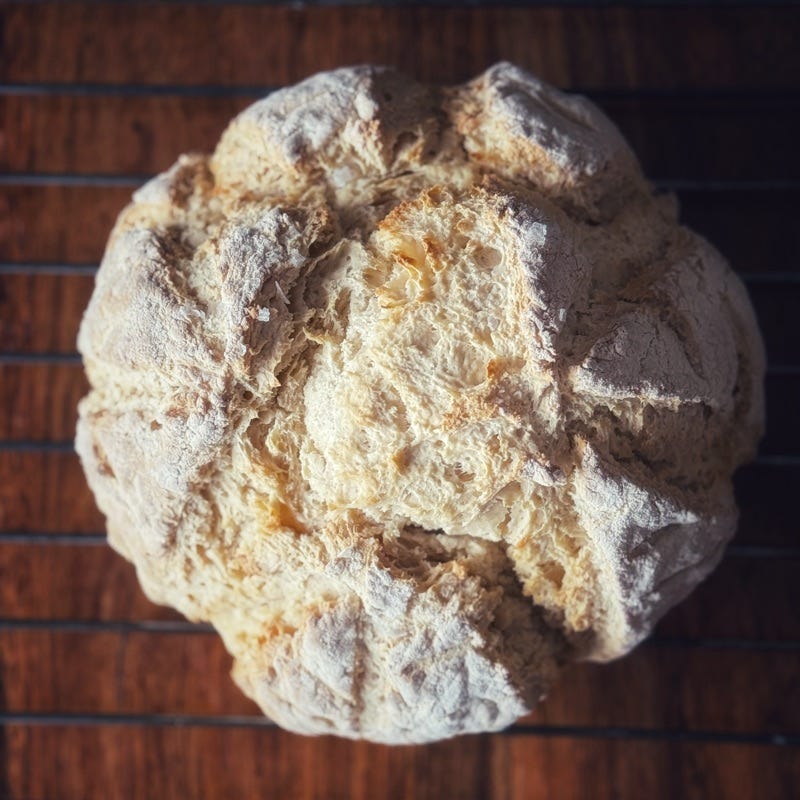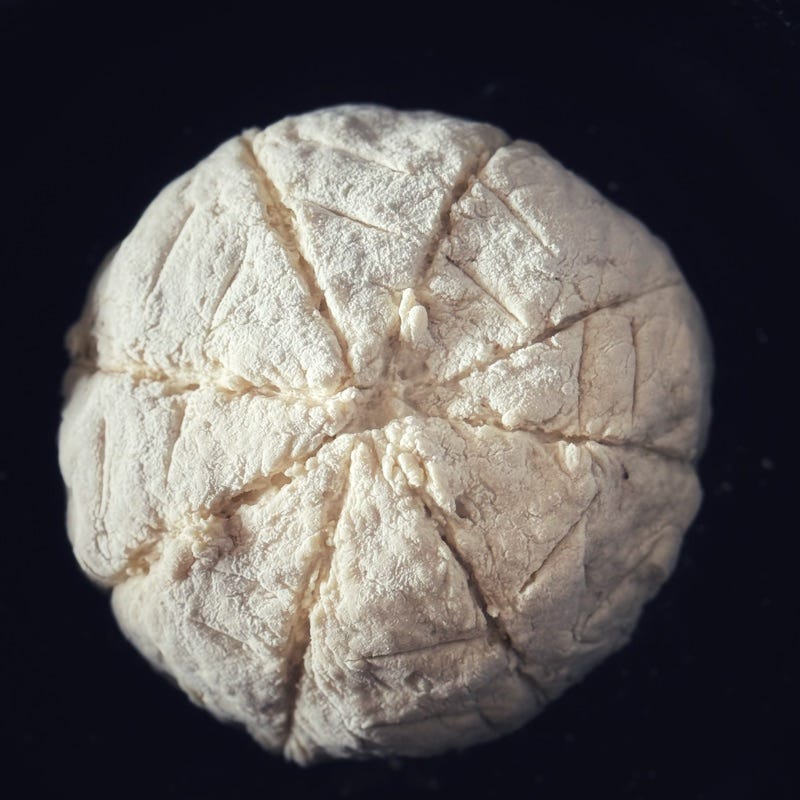damper . soda bread . the tale of two crumbs
Don't put a damper on it. Evolution of ingredients. Just a tiny slice of this subject. Two tiny comparisons.
One of my super powers is adaptation. (The other is sleep 😴), (laughs to self) I have always seen life as a river. Sonwtimes I say to myself - you are water. (I know: it sounds so gaggy but it works for me). Sometimes I need a life jacket sometimes I can just float along in an inner tube. Today I am floating along. Adapting. We all have this skill by the way. Of adapting. Scooping up new useful stuff and blending it into our stories. And our recipes.
If you Like what you read Hit LIKE ❤️ on your way past. We love a good Like!
I am fascinated by how peoples, whole generations, adapt food to their environments, often creating dishes remarkably similar to those found in other parts of the world. The movement of ingredients with the movementof immigrants. Damper was a bush bread by First Nation Australians long before Irish soda bread arrived in Australia with immigrants, yet the two are similar. Let’s compare Australian damper and Irish soda bread - both are breads that were, and still can be, cooked over or under a fire.
Let’s not put a damper on it! And let’s look at damper first. Because it has evolved according to the times.
So why damper?
If you have a fireplace you will know about dampers. A damper is a lever that will cut off the air from the fire. Slowing it down for the night. When I cooked on a coal range - when my own babies were babies - I would cover the coals with ash to damp them down for the night. In the morning I uncovered the coals added kindling and blew the fire back up.
Australian Damper
Was cooked on or under the coals.
The Aboriginal (original) peoples of Australia or Australian First Nations - these most extraordinary peoples, these ancient communities of Australia - have likely been making mingari - what we are calling damper - since the discovery of grinding stones and the harnessing of fire (First Nations Australian communities were using fire to manage the bush around 120,000 years ago). Long long before the white-fella came. The flour ground from the wild seeds was mixed with water and cooked in the coals. They would scoop a hollow in the ground to cook yams and other small vegetables, piling ash and hot coals on top to create a slow oven.
The bread was probably closer to a flat bread than the damper I made yesterday.
In Cuddie Springs, located near Brewarrina in central north New South Wales, archaeologists found grinding stones dated to about 30,000 years ago. These stones were used to grind wild seeds into flour. They did not have wheat but used the seeds from
Spinifex
Kangaroo grass
Mitchell Grass
(With my interest in wheats I will continue research into these grasses - fascinating stuff - into my spreadsheet they go).
Later, (much, much, much later) the loaf called damper got its first documented colonial rendition from William Bond, a convict transported on the First Fleet, and recognised (rather loftily I think) as Australia's first baker (with a bakery). With the colonials came wheat. His Damper was made with milled wheat or barley and was a bush bread for diggers and drovers and swagmen and gold diggers and white-fella pioneers of the time.
William began advertising his bakery in Sydney in 1804, operating from Pitt Street and much of the bread he baked in those early days was this simple ash-cooked loaf.
And because this piqued my interest I veered off my study of grasses and early grains and I had to find out (immediately because I am like that) what crime William had committed to be sent to the antipodes.
A first sweep revealed that William was tried at the Exeter Assizes on 18 July 1785 for stealing household goods valued at 164 shillings. Initially sentenced to death, his punishment was later commuted to seven years' transportation. He was transported to New South Wales aboard the Charlotte as part of the First Fleet, departing England in May 1787.
The group he emigrated with was known from then on as the First Fleeters.
Obviously that was not enough so I dug deeper. Thanks to a number of Australian history sites:
William Bond was found guilty on 18 July 1785 at Exeter, Devon, of stealing 20 yards of muslin and other goods from a house. His death sentence was commuted to 7 years transportation. He was sent to the Dunkirk hulk until he embarked on the Charlotte for New South Wales, arriving in January 1788 as part of the First Fleet.
On 7 January 1789 Bond was sentenced to receive 150 lashes for being 'in liquor' and insolent to a sentinel. He received a further 25 lashes on 13 March for 'neglecting his Business as Baker at the Hospital'. Bond married Sophia Parker on 18 March 1792 at Parramatta.
Bond advertised as a baker in Sydney in 1804. He died in 1839 at Pitt Street, Sydney; his age was given as 109 (though he was actually in his 80’s - ancient typos).
A scrapping, drinkin’ criminal immigrant. Just sayin.
Australian Damper
3 cups self raising flour (Williams damper would have been made with plain flour)
1 tsp salt
1 cup water (add more if needed)Mix into a soft dough. Shape into a round. Score a cross in the top. Wrap. Place straight into the ashes of a fire, cover with hot coals. Bake about 30 minutes. Or bake in a hot oven (200°C) on a cast iron skillet, dusted with flour, until golden and hollow-sounding underneath. Place your cast iron into the oven/fire to heat before adding the dough.
Eat warm, pulled apart, with butter
Cooking Method: Originally baked in the ashes of a campfire (in a cast iron pot or directly under dying coals).
I tried to find Williams recipe for damper and have not found it so far but I am fairly willing to bet it was a flatter bread because of this partial timeline from my rising agents timeline spreadsheet:
1804 William Bond opens his bakery in Sydney selling damper.
1822 Dried yeast was first sold commercially in Vienna.
1830 Baking soda introduced to Ireland
1839 William Bond dies in Sydney
1843 Baking powder created by Alfred Bird in England
1852 Baking soda introduced to Australia
1860 Baking powder and baking soda were more common in recipeps for households and bakeries in Europe and America and Australasia.
*The word “yeast” was not linked to fermentation until 1859.
All the contemporary damper recipes I found have baking powder in them. And as you can see these rising agents were not yet available so I assume that the original damper breads that William was baking were small round hand breads and nothing like the damper I am eating here in Aussie now.
I really liked the damper I made the other day though the birds were not quite as enthusiastic - as it cools it hardens fast!
Let’s take a quick look at Irish Soda bread on our way past.
Soda bread originated in Ireland in the early 19th century, when baking soda became available as an affordable alternative to yeast, which was not easily accessible at the time. Buttermilk reacts with the baking soda, causing the bread to rise without using yeast
Irish Soda Bread
3 cups plain flour
1 tsp salt
1 tsp baking soda
1 cup buttermilk (add a splash more if too dry)
Mix dry ingredients. Pour in buttermilk. Bring together with your hands - don’t overwork it. Shape into a round, cut a deep cross. Bake at 200°C on a hot floured cast iron griddle or tray for about 35–40 minutes until golden and sounds hollow underneath.
Best eaten warm, broken open, with butter and jam.
Cooking Method: Traditional Irish soda bread was often baked in a bastible - a cast iron pot with a lid - a Dutch Oven - set over an open fire or covered with hot turf or wood embers. Or in the coal ranges of the more wealthy cottage kitchens.
Before the advent of bicarbonate of soda, the Irish leavened their soda bread with potash, which eventually led to the development of bicarbonate of soda (see above for that timeline).
The Irish made great sourdough breads from wild yeasts which is another discussion - and a tasty one.
My Mum used to make her scones in a similar loaf shape to damper and soda bread, with deep scores for pulling apart later. But never on a fire. My mother was a modern 60’s woman. She had an electric oven! The shape she used interests me though, it could have been passed down by our old people the majority of whom were Irish.
These un-yeasted breads are humble, practical loaves shaped by what was on hand: a fire, some kind of flour, and a rising agent or none at all. Each one is a product of resilience and adaptation and each tells a story about place, people, and resourcefulness. Talking around a fire while the breads cooked.
Sitting around the kitchen table is the modern equivalent of sitting around a fire eating hot bread fresh from the ashes. Do you agree?
Have you eaten damper? What are the simple un-yeasted breads from where you live?
Have a fab day!
Celi.
PS my next post is a spin off into little breads. Like soda farls, and bannock!
PS This is why I am taking so long to get a post out nowadays!









I love the history lesson along with the recipe. It always tastes better when you know the history!!
Well that was an interesting read - these days Australia exports criminals - how times have changed